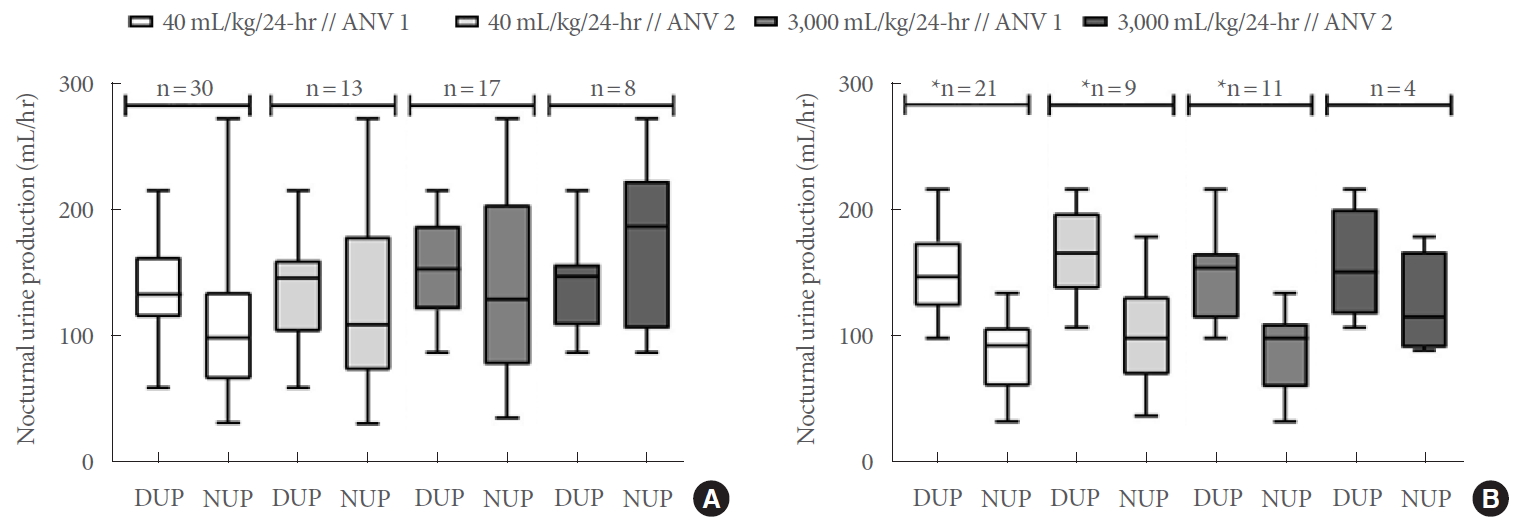1. D’Ancona C, Haylen B, Oelke M, Abranches-Monteiro L, Arnold E, Goldman H, et al. The International Continence Society (ICS) report on the terminology for adult male lower urinary tract and pelvic floor symptoms and dysfunction. Neurourol Urodyn 2019;38:433-77. PMID:
30681183 

2. Cornu JN, Abrams P, Chapple CR, Dmochowski RR, Lemack GE, Michel MC, et al. A contemporary assessment of nocturia: definition, epidemiology, pathophysiology, and management--a systematic review and meta-analysis. Eur Urol 2012;62:877-90. PMID:
22840350 

3. Everaert K, Herve F, Bosch R, Dmochowski R, Drake M, Hashim H, et al. International Continence Society consensus on the diagnosis and treatment of nocturia. Neurourol Urodyn 2019;38:478-98. PMID:
30779378 

6. Denys MA, Cherian J, Rahnama’i MS, O’Connell KA, Singer J, Wein AJ, et al. ICI-RS 2015-Is a better understanding of sleep the key in managing nocturia? Neurourol Urodyn 2018;37:2048-52. PMID:
27653805 

7. Hui C, Radbel JM. Diabetes Insipidus. StatPearls. Treasure Island (FL): 2020.
8. Monaghan TF, Rahman SN, Bliwise DL, Michelson KP, Agudelo CW, Miller CD, et al. Identifying men with global polyuria on a nocturnal-only voiding diary. Neurourol Urodyn 2020;39:347-52. PMID:
31692071 

9. Goessaert AS, Krott L, Hoebeke P, Vande Walle J, Everaert K. Diagnosing the pathophysiologic mechanisms of nocturnal polyuria. Eur Urol 2015;67:283-8. PMID:
25240972 

10. Denys MA, Decalf V, Kumps C, Petrovic M, Goessaert AS, Everaert K. Pathophysiology of nocturnal lower urinary tract symptoms in older patients with urinary incontinence. Int J Urol 2017;24:808-15. PMID:
28815743 

11. van Doorn B, Blanker MH, Kok ET, Westers P, Bosch JL. Prevalence, incidence, and resolution of nocturnal polyuria in a longitudinal community-based study in older men: the Krimpen study. Eur Urol 2013;63:542-7. PMID:
23083901 

12. Tikkinen KA, Johnson TM 2nd, Tammela TL, Sintonen H, Haukka J, Huhtala H, et al. Nocturia frequency, bother, and quality of life: how often is too often? A population-based study in Finland. Eur Urol 2010;57:488-96. PMID:
19361907 

14. Tikkinen KA, Auvinen A, Tiitinen A, Valpas A, Johnson TM 2nd, Tammela TL. Reproductive factors associated with nocturia and urinary urgency in women: a population-based study in Finland. Am J Obstet Gynecol 2008;199:153.e1-12.

15. Weiss JP, Blaivas JG, Stember DS, Brooks MM. Nocturia in adults: etiology and classification. Neurourol Urodyn 1998;17:467-72. PMID:
9776009 

16. Mueller E, Latini J, Lux M, Stablein U, Brubaker L, Kreder K, et al. Gender differences in 24-hour urinary diaries of asymptomatic North American adults. J Urol 2005;173:490-2. PMID:
15643226 

18. Firsov D, Bonny O. Circadian regulation of renal function. Kidney Int 2010;78:640-5. PMID:
20664559 

19. Liu J, Sharma N, Zheng W, Ji H, Tam H, Wu X, et al. Sex differences in vasopressin V(2) receptor expression and vasopressin-induced antidiuresis. Am J Physiol Renal Physiol 2011;300:F433-40.

20. Juul KV, Klein BM, Sandstrom R, Erichsen L, Norgaard JP. Gender difference in antidiuretic response to desmopressin. Am J Physiol Renal Physiol 2011;300:F1116-22.

22. Bennett E, Peters SAE, Woodward M. Sex differences in macronutrient intake and adherence to dietary recommendations: findings from the UK Biobank. BMJ Open 2018;8:e020017.

23. Krishna GG, Newell G, Miller E, Heeger P, Smith R, Polansky M, et al. Protein-induced glomerular hyperfiltration: role of hormonal factors. Kidney Int 1988;33:578-83. PMID:
2834601 

25. Perrier E, Rondeau P, Poupin M, Le Bellego L, Armstrong L, Lang F, et al. Relation between urinary hydration biomarkers and total fluid intake in healthy adults. Eur J Clin Nutr 2013;67:939-43.


26. Sailer C, Winzeler B, Christ-Crain M. Primary polydipsia in the medical and psychiatric patient: characteristics, complications and therapy. Swiss Med Wkly 2017;147:w14514. PMID:
29120013 
28. Matsuo T, Miyata Y, Sakai H. Effect of salt intake reduction on nocturia in patients with excessive salt intake. Neurourol Urodyn 2019;38:927-33. PMID:
30706965 











